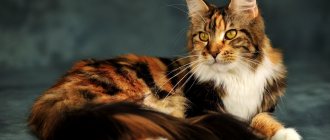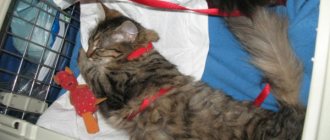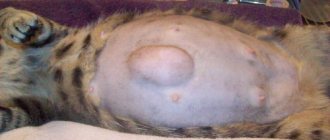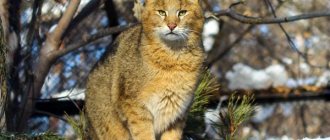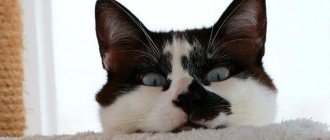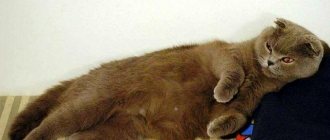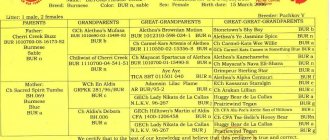Plain (solid, solid)
The monochrome uniform coloring of Scottish cats is considered classic by breeders. The solid or solid color of the animal implies the absolute exclusion of any inclusions, small marks and specks of a different color. The tone is rich, even along the entire length of the coat.
The most common used to be considered blue plain Scots. But today among the representatives of the breed there are many other variants of solid colors.
White
A Scottish cat with snow-white fur (without yellowness) looks luxurious. Possible eye colors are blue, amber, copper. According to the standard, eyes of different colors are allowed. The paw pads and nose are light pink.
Kittens may have markings of a different shade, which disappear after the first coat change. By the age of two, the coat of a white Scot should be crystal clear, without spots of a different color.
Black
The black cat has expressive yellow eyes. The nose and paw pads practically blend into the main color of the animal.
On the shiny bright coat of the Scottish beauty Ebony, 2-3 hairs of contrasting white color are allowed. The presence of large red or brown marks is not provided for by the standard.
Important: Scottish Fold pets are endowed with magical abilities. It is believed that it is the black color of the Scottish Fold that protects the house and its inhabitants from evil spirits.
Chocolate
The brown Scottish cat, also called chocolate, looks noble and impressive. The color of the coat contrasts with the animal's yellow, golden or copper eyes. The nose and paw pads are also dark brown.
Lilac (lavender)
The monochromatic lilac Scottish Fold has a gentle gray tint that smoothly turns into cream. The nose is slightly brownish, the paws on the bottom are the same color as the coat, in harmony with the main color of the pet. This lilac-lavender color goes well with eyes of copper, amber or orange shades.
Red (red)
Red or ginger color is a rare and valuable color of the Scots breed. The fiery edge is combined with burning amber irises. Pads and nose to match the dominant color.
The tail of kittens and adult animals is not very evenly colored. This deficiency does not disappear with age and is allowed by the standard. And the presence of marks on the head and limbs that remain after reaching the age of two are considered a deviation from the norm.
A red Scottish straight-eared cat can give birth to kittens not only with erect ears, but also with ears pressed to the head.
Cream
The cream or peach fold cat is infinitely elegant and beautiful. The delicate background of light fur, bright golden eyes and a pinkish nose give the pet an irresistible appearance. The pads on the paws are also pink. An animal with this color is similar to a red Scotsman, but its coat color is a shade lighter.
A peach fold kitten may have a blurry, fuzzy pattern on its paws and tail that does not disappear with age. This is not critical for a purebred pet, but leopard markings are absolutely unacceptable.
Faun (deer)
There is another unique color of Scottish fold cats with an interesting name - fawn, which means “young deer”. The nose and pads on the paws of these beauties are beige-pink.
Cinnamon
Cinnamon is a lighter and more delicate color than chocolate, but darker than red. The nose and paw pads of such animals are brown, beige or pink.
Blue color (blue)
The gray or blue Scottish cat has very beautiful amber eyes. The coat tone of a purebred pet can belong to any range of gray - from the lightest (blue) to completely dark (blue). At the same time, each hair is saturated and well colored, without streaks.
The nose and pads practically do not differ in color from the plain coat.
A gray Scottish Straight cat may be marked with a few streaks and drawings in childhood. But as they grow older, these color flaws go away.
Primary colors
There are primary coat colors for Scottish cats. Any color of an animal can be classified into one group or another:
- tabby;
- solid (plain);
- chinchilla;
- smoky;
- shaded;
- with a white base;
- colorful (colored);
- tortoiseshells.
These colors are considered the most important for classifying an animal by its color. Each cat of the Scottish breed can be classified into one of the listed groups.
Scottish Straight Color Point
Plain
Another name for this group is solid colors. This type includes monochrome animals with uniform tinting of the coat in one color. Since the British breed was of particular importance when breeding the Scots, the Scottish coat received blue and gray tones, and the color of the iris acquired an amber color. Various variations of genes (dominant, recessive) determined the appearance of different colors of Scots. These can be a variety of shades:
- black or ebony;
- milk chocolate or cinnamon;
- chocolate or brown;
- “deer” – faun;
- red (red);
- soft gray with a pink undertone – lilac;
- pure white.
White Scottish Fold.
A cat's eyes directly depend on the color of its coat. White pets tend to have blue or different colored eyes (heterochromia). Purple and black cats have irises of yellow and copper shades. Amber is typical for individuals of chocolate colors. This type of wool should not be interspersed with any other color. The tone should be rich and uniform along the entire length of the hairs. The presence of marks on the coat means the presence of a defect, which reduces the value of the cat if it takes part in professional felinologist exhibitions.
Cats of this breed, colored pure black, white, red, chocolate, are considered rare. Such kittens will be more expensive. Precious colors - gold and silver - are also considered solid. The task of any breeder is to preserve the purity of the color and its breed type. They are unstable when crossed and are very finicky about adding a new set of genes.
Two-color or bicolor
This term refers to the combination of half the wool is white and the second half can be colored in other colors, for example:
- blue;
- cream;
- red;
- tabby
In the latter case, the pattern must be strictly symmetrical. With this combination, animals can be called cream bicolor or red bicolor.
Blue straight-eared bicolor
Cream bicolor fold
Red bicolor straight
Tabby bicolor fold
Point
The body of the animal has a light basic shade, some areas are painted in darker colors. This is a group of oriental colors (originally found in eastern cat breeds). A similar color is also found in Persian, Fold, Thai and other cat breeds. In turn, color points are divided into subspecies, of which there are 20. There are basic or classic combinations that occur more often than others:
- Seal Point - These cats have a basic white or cream color with dark brown and black spots on the body. In the English version the color is called seal-point.
- Blue point - blue or gray spots on a white-blue background. Other cool shades may occur.
- Chocolate point. The general color of the animal is similar to ivory, and the markings are a brown chocolate shade, but several tones lighter than those of seal points.
- Lilac. Another name for lilac (lilac-point). These cats have spots of brown or gray-pink, lilac, and the body of the animal is light beige.
Interesting read: who are the lop-eared Britons?
Using these colors, breeders created other shades that are now widespread. Such derivatives are:
- cream points – soft cream-colored spots on the cat’s body located on white fur;
- red - red spots on a light body (sometimes pure white);
- torti - similar to tortoiseshell. The main feature is that it occurs in females. The markings are heterogeneous and can be in the form of a mix of spots of brown, red, cream, and blue. Another feature is that their shade changes with age;
- tabby - the markings are striped, the colors may vary, and the body is predominantly light.
There are also rare points that are considered exotic:
- Cinnamon Point - Markings are cinnamon colored on a beige body. The skin on the pads is light pink;
- faun - light purple markings located on the beige body of the animal.
It is characteristic of all points that the color depends on the animal’s body temperature (in the cold, the colored areas become a little darker and more saturated). Breeders are constantly working with this group to create more interesting marking colors.
Torties or tortoiseshells
Tortoiseshell, also called tortoiseshell, is similar to the coloring of a turtle's shell. Such cats have an interesting pattern on their body, similar to this reptile. This coloration can be unpredictable and may change. This happens after every molt, which occurs twice a year. In this case, the design, pattern, and color of the marks may change. Individuals with this color are almost always sterile and are found only in cats.
Cats with such fur are extremely rare. The color scheme is usually formed by combinations of red, black, and cream colors. Individuals with a color distribution proportion of 1:1:1 look most impressive. There are several features of this color:
- In blue tortoiseshell cats, black can be replaced by blue, red by cream. This creates a bluish-cream combination.
- Purple is replaced by black and red, and cream by purple.
- Chocolate turtles have a black to chocolate substitution.
There are a variety of combinations. The main requirement is a symmetrical, uniform pattern throughout the animal's body.
Smoky
This type is also called smoky or smoky (from the English “smoke” - smoke). Such a cat should have a uniform color without inclusions. The base is silver-white wool. Part of the hair is black, the rest is silver. This type belongs to the silver group. This phenomenon is formed by the dominant gene of this color.
Smokey should not have a pattern, but this can sometimes happen. It can be perceived as a solid (solid) color, but this is wrong. The animal's hair is colored 2/3 of its length and is called shaded. If your pet has thick fur, you need to part the fur to see the color of the base.
Tabby
The animal may have eyeliner on the nose, eyes, a pattern on the chest that resembles a necklace, rings on the tail, paws, spots on the ears or cheeks. There may be a line around the nose. The stripes on the body should not be wide. Marbled species may show a gradual transition to spots on the belly or neck. This pattern stands out against the general background of the pet’s color. There are different tabbies:
- Tiger or mackerel. Such animals may have narrow stripes directed vertically. A pattern resembling a collar appears on the neck. The side stripes rise up the back, forming a saddle-like pattern here.
- Spotted or spotty. Spots of various shapes and sizes have clearly defined boundaries. A line is formed along the entire length of the spine.
- Shaded, whiskey or marble. The pattern consists of spots and stripes that are scattered over the entire surface of the animal. Such animals can have any coat color, the main thing is that they have a pronounced pattern against the general background. It owes its name to its similarity to this textured stone.
Tabby Scottish fold.
Tabbie can also be classified by color:
- Silver. It is the main one, on which a black pattern is applied.
- Silvery blue. The undercoat is white on the sides, face and tail of the animal.
- Reds. Red base with rich red patterns.
- Brown. The wool has a dark copper color, on which a black pattern is drawn.
- Blue. Refers to cream and blue tones. The pattern is expressed against the general background.
- Cream. The base of the wool is light, the pattern contrasts against its background.
- Cameo. White base with red stripes.
This coloration suggests the presence of a zonal pattern on the body. It can be in the form of the letter “M”, which is located on the animal’s forehead.
Paticolor
Characterized by the appearance of white spots of different sizes and shapes. It could even be a white cat with a few spots of a different tone. Two options are considered standard, there are eight in total. The ideal is 1/3 to ½ white. If a cat has more than 90% of its entire surface painted white, the color is called “harlequin”. If an animal has a colored tail, then it is a van.
Scottish Fold Paticolor.
Chinchilla
The basis of this color is tipping. This phenomenon is characterized by the coloring of 1/8 of the hair, most of which is white. A kitten gets this color if both of its parents are colored in the same way. There are three main types of chinchilla:
- golden;
- blue;
- unique.
Silvers may have stripes or shadow marks on their tail. The eyes are green and the nose is beige. The golden chinchilla is characterized by the presence of a reddish tint on the back, sides, and tail.
Ticked
This color is considered rare for this breed; kittens with a similar color are highly valued. The peculiarity lies in the color of the hairs. The hair should have three stripes of different colors. Also, such cats are sometimes called Abyssinian. This creates the image of small specks on the animal’s fur. There may be stripes on the paws and tail.
Interesting read: what to feed the Scots.
Shaded
The coloring extends to the upper third of the hair. The rest of the body is painted white. Such individuals have a light undercoat. The coat is shaded on the sides, back, and head. Golden, silver, and red colors can also be shaded.
Wang
White body except for tail and muzzle. There may be several spots on the animal's body and paws. Their coat is unevenly colored and looks like a tabby.
Harlequin
4/5 of the wool is dyed white. The spots are scattered randomly over the entire surface.
Shaded
ticked
Harlequin
Wang
Cameo
brindle
Two-color
A unique coat color is bicolor (two-color cats). The main background is snow-white. The second color in color (cream, black, blue, red) is presented in the form of unusual patterns. Thoroughbred representatives must have white belly, neck, chest, paws, muzzle and beard.
A prerequisite is the predominance of a white background in color. Bicolors are more valued; their body patterns are symmetrical. The eyes can be any shade, but are usually blue or golden yellow.
Cream bicolor
Cute white cats with additional streaks of delicate cream tones. The eyes are blue or yellow, and the nose and pads are pink.
Blue bicolor
The pattern on the wool is blue (delicate or rich gray). The iris of the eyes is a beautiful sky tone or yellow-orange. The nose and paws below are pink.
Black bicolor
Black and white bicolor is characterized by patterns of rich black tone. These cats have a pink nose and blue or copper eyes. A symmetrical, distinct pattern on the skin turns the cat into a real gentleman in a tailcoat.
Harlequin
The name was given because the owner of the color is similar to a harlequin. The main color of the coat is white. And only ⅕-⅙ of the body area are colored spots. They are not concentrated in one area, but can be scattered throughout the body.
Photos of harlequin cats:
Color point
Color-point is translated from English as “colored point”. The point coloring is explained by the presence of a gene, under the influence of which the coloring of hairs intensifies in some areas of the body with insufficient blood circulation. Characteristic darkening appears on the main white or cream background of the coat.
The second name of the color is Point Links. The eye color of cats of this color is necessarily blue. Previously, this coat color was observed only in the Siamese breed. But today it is present in other cat species, including Scots.
Newborn kittens are completely white. Only by the age of one month do babies begin to show color on their ears, paws, tail and face. According to this color, several subspecies are distinguished among the points.
Blue Point
This color is characterized by a pale gray-blue, almost white shade of the body with darker, gray markings. Soft gray Scottish blue point kittens have paws and noses that match the main color.
Cream point
The body is creamy white, and the shading on the animal’s face and tail are pastel cream colors. Paw pads and nose are pink. This point color goes harmoniously with the expressive blue eyes of the cat.
Lilac Point
The dominant tone is soft white or lilac, and the markings are gray with a pink tint. The nose and paws are the same as the main color.
Seal Point
The darkest color among the points. The dominant tone is beige. Contrasting with it are brown and black markings. The same dark nose button and paw pads.
Chalklit Point
Chocolate or choclit point is distinguished by a brown pattern on a cream background. Paw pads and nose range from light cocoa to darker brown.
Red point
The main coat color is pale apricot, almost white. Darkening on certain parts of the body is red-red in color. The pads and tip of the nose are bright pink.
Characteristic
Such a fluffy will definitely get along with the people around him.
Black cats are considered the most obedient, kind and responsive, especially when compared with the characters of individuals of other colors. But this is only true for males. Smoky “emers” are often credited with being unobtrusive, but not shy either. They get along well with people and animals. Each breed has its own personality traits. For example, the Scottish representative knows how to make a show by begging for delicacies. The cat stands on its hind legs and, moving its front legs, looks intently into the eyes.
Tortoiseshells (torties)
The tortoiseshell color of Scottish Folds is usually tri-colored. Red, white, and black spots are located on a cream or red dominant background. When the genes of the parents are combined in a tortoiseshell kitten, these markings can take on chocolate, blue and cream shades.
When assessing tortoiseshell cats, felinologists pay attention to the even distribution of markings and the intensity of their tone. Fold-eared and straight-eared Scots with a tortoiseshell color are divided into subspecies (depending on the color scheme of the spots).
Black-red
There are black and red-red patterns all over the cat's body. The sizes and shapes of the spots are very diverse. This color is often called tortie.
Chocolate red
The patterns on the wool are brown and red. They stand out against a lighter background and look very interesting. The chocolate red color is considered rare and prized by breeders.
Blue-cream
The tortoiseshell blue-cream color in Scottish pets is determined when the main gray-blue background is covered here and there with small light cream spots.
Important: tortoiseshell coloring is characteristic only of cats. The calico cat is very rare. The appearance of a male tortoiseshell kitten indicates genetic problems. Most likely, an adult pet will not be able to have offspring, since the reproductive functions of its body are impaired.
Character and temperament of the Irish cat
Representatives of the British breed are independent, do not like to be held and do not suffer from loneliness if the owner is away from home for a long time. All this cat needs is food and water.
Sometimes owners share observations about their Britons and note their extraordinary ability to sleep 20 hours a day. Traditional English cats also tend to show aggression.
The Scots differ from them in temperament and character:
- they are affectionate and sociable;
- take part in games with pleasure;
- get along well with other pets.
Smoky (smoky, tuxedo)
The color of Scottish Fold cats can be smoky. On top the coat is one color, for example black. And at the base, each hair is silvery-white. This coloring is characteristic of cats with a dominant silver gene, which creates unusual combinations of light and dark shades.
Smoky color is easy to confuse with solid color. To avoid mistakes, you just need to look at the undercoat. With a smoky color, the undercoat of a different shade is clearly visible, and with a solid color, the color of the roots does not differ from the tips.
The eyes of smoke cats are usually yellow-gold in color. Based on the shades of smoke on the fur, several subspecies of this color of animal are distinguished.
Blue smoke
Smoky blue Scottish Straights and Scottish Folds are distinguished by the color of their fur coat with a gray cold coating. But underneath the fur is white and silvery. The paw pads and nose of these pets are gray-blue.
Black smoke
This color in Scottish cats is characterized by a black edge, but the hair at the roots is white. The nose mirror and pads do not differ from the main background.
Chocolate smoke
The snow-white undercoat is combined with a brown-chocolate topcoat. The nose button and paw pads of these animals are brown in color.
Smoky Scottish Straights and Scottish Folds, despite their unique color, cannot participate in exhibitions. Such cats are not recognized by the breed standard.
Mr. Cat recommends: the most characteristic breeds with tabby color
There are a great variety of tabby cats, ranging from the most common outbred pets or street (yard) cats. The elite cats bred by breeders in nurseries include, for example, the following tabby-colored cats:
- Australian Mysts;
- Arabian Mau;
- Bengal;
- British Shorthair;
- Egyptian Mau;
- Leohouses;
- Maine Coons;
- Oriental;
- Ocicats;
- Pixie Bobs;
- Savannah;
- Safari;
- Serengeti;
- Siberian;
- Sokoke;
- Toygers;
- Ceylonese;
- Chinese Li-Hua;
- Highlanders;
- Scottish Fold and Straight.
Fold
Straight
The only breed in which the type of color is present even in the name is the Asian Tabby.
Asian tabby
This is a rare short-haired breed, bred in Great Britain probably in the 80s of the last century.
The animal is very active, loves to “talk”, but is not mischievous, and gets along well with all household members, including children and other pets.
This adorable cat has a friendly personality, making him a good choice for a family home despite his overly inquisitive nature.
This member of the Asian cat group comes in four different tabby patterns: classic, mackerel, spotted and ticked. Although there are both tortoiseshell and solid colors. A variety of stripes, swirls, rings and spots are observed in a wide range of beautiful colors.
The most common pattern is the tabby stripe, in which each hair has a contrasting stripe of color. Like all of its ancestors, the Asian Tabby has the graceful, muscular lines and extroverted personality of the Burmese cats used in its development, mixed with the calmer nature of the Persian Chinchilla.
The animal is medium in size, weighing from 4 to 7 kg.
Tabby colors
Scottish tabby cats are very popular among breed lovers. This color suggests the presence of patterns on the pet’s fur.
Depending on their shape and size, tabbies are divided into three types:
- Striped (tiger) color - the presence of clearly defined vertical stripes.
- Spotted (leopard) - the pattern is made up of spots on the animal's fur.
- Marble color is a pattern of larger chaotic marks of different shapes.
A prerequisite for tabby cats is the presence of the letter “M” on the top of the animal’s forehead. The color combinations of wool are surprising in their diversity:
- cream;
- golden;
- blue;
- marble on silver;
- black marble;
- silver;
- silver-blue.
Important: Scottish tabbies with a silver tabby color resemble the mustachioed pet from a cat food commercial. Many believe that it is the Scottish straight-eared cat with a tabby pattern that appears on the screen. This color is also called the whiskey color of Scottish cats.
A little genetics - how the marbled pattern is formed in a Scottish Fold cat
Decoding the cat genome is still in its infancy. Scientists figured out some elements quite quickly, but they are still very far from complete clarity.
Tortoiseshell and lilac Scottish folds are lucky in this sense. The basic hereditary rules have already been studied, the genes that are responsible for this color have been identified, and therefore selection does not face any serious problems.
The tabby trait (gene T) is responsible for the formation of a brindle pattern on a cat's coat: narrow necklace lines around the neck, thin stripes from top to bottom across the body, rings on the tail. The T gene is dominant over all others.
Next come the transformations of the T gene, which form other patterns on the animal’s coat:
- Allele Ta – Abyssinian color. It is recessive to pure T, but dominant to all subordinates.
- Combination TsTs – spots on the skin. Scientists suggest that breaker genes are responsible for such coloring (they have not yet been studied for sure). They influence the formation of tiger and marble patterns. But this theory still remains at the level of scientific hypotheses.
- In last place is the TbTb gene. In Scottish Folds and other cat breeds, it is responsible for the formation of the marbled pattern. Recessive to all variants without exception and therefore extremely capricious in breeding.
The next point is the agouti trait (gene A). It can take a dominant (A-) and recessive (aa, non-agouti) form. In the first case, the tabby pattern on the coat will appear, and in the second it will be hidden. Therefore, in lilac and tortoiseshell colors, agouti should always be present in a dominant state (A-).
Now about the flowers themselves. The genetic nature of color in Scottish Fold cats in the lilac and tortoiseshell groups differs.
First about purple cats. To understand all the relationships, you need to turn to the black (dominant B gene). In the bb allele it produces a chocolate shade.
The D gene in the recessive state dd changes the shades of the primary color and expands the palette. When dd is combined with black, it turns blue, red becomes cream, cinnamon cinnamon turns into sand fawn. And chocolate bb plus dd brightener together add up to a purple color. As a result, the genetic formula for the merle lilac will look like A-tbtbbbdd (dominant agouti first, then merle tabby, chocolate color and lightener).
The nature of the origin of tortoiseshell color in Scottish Fold cats is different. The A and T genes remain in place, the chocolate and lightening components (bbdd) are also present, but one additional element appears in the formula - the O (orange) gene.
We are talking about a gene that in the dominant state gives O-red (red) color, and in the recessive state it gives black. It is interesting because it is attached only to the X chromosome, which, in turn, affects the sex of the future Scottish kitten. In practical terms, it looks like this.
- set XX is a cat.
- combination XY is a cat.
Cats only have one X chromosome and therefore can be either ginger or not ginger. In cats, two dominant O- give a red color, two recessive O- give a black color, and in a set of O- the result is tortoiseshell. The lilac color of a tortoiseshell cat is written with the following formula - A-tbtbOobbdd. All its components duplicate the usual purple color with the addition of the “turtle” Oo allele.
This is interesting! Lilac Scottish “turtles” are always cats. Cats can acquire this color only in the case of a genetic mutation, which is expressed by an additional X chromosome (XXY). But such boys remain infertile and do not continue their family line.
Chinchilla
The Scottish chinchilla borrowed the extravagant colors of its coat from the British, and they, in turn, from Persian cats. A chinchilla kitten is born only from parents with an unusual color. Each hair is colored in two colors.
Most of it is light in color and 1/8 of it (the top) is dark in color. This phenomenon is called tipping.
Tipped chinchilla colors can be of 3 types:
- Golden. The cat has a white undercoat. But on top there is a reddish coating over almost the entire surface of the body (on the sides, back and tail of the animal). Only the beard, the tips of the ears and the belly are white. Yellow-gold eyes, pink pads and a brick-colored nose.
- Silver. White wool coated with silver gives an interesting gray effect. The color of the tail has a hint of stripes, the nose is beige, and the eyes are green. Snow-white tips of the pet's ears, chin and belly.
- Blue golden. The rarest and therefore valuable color of Scottish chinchillas. The undercoat is a delicate caramel color, and the tips of the hair are a radiant blue hue. The eyes are natural emeralds of a rich green tone.
Feeding an Irish cat
All English breeds are prone to overeating, especially in the second half of life. Therefore, the owner must strictly control the volume of portions and monitor the pet’s physical activity.
The diet for Irish cats depends on the age of the animal:
- As children, they love natural products, and the owners prepare food for the kids themselves. This is a great way to keep the balance of nutrients normal and adjust the menu as necessary.
- Adult cats are switched to industrial food. Dry granules are available in a wide variety of formulations with effective additions of vitamins and microelements.
- In old age, metabolism decreases, problems with teeth, hair and the musculoskeletal system appear. Therefore, animals are transferred to a combined diet - ready-made food and natural products.
The difficult nature of the British does not manifest itself in their pickiness about food. They have a normal attitude towards all products and do not require any “aristocratic” delights for themselves.
Shaded (shedded) colors
An unusual definition refers to the interesting color of Scottish cats - shaded colors. These pets have almost white fur, but the tip of the guard hair is colored.
The top layer of a cat's coat can be any shade typical of Scottish cats. The undercoat is white. The sides, back, head, tail and ears are shaded. Light belly, chin and lower tail. There should be no obvious spots. The “M” sign on the forehead and darkish rings on the paws are acceptable.
Shedded colors can be of three varieties:
- Golden. The fur of the Scottish cat is golden, the undercoat is cream or light peach. Green eyes are very expressive and beautiful. The nose button and paw pads are chocolate.
- Red. This type of shaded color has a dark red coating on the coat with a snow-white undercoat. The eyes are amber, the pads and nose are pink.
- Silver. The white undercoat combined with the dark gray topcoat produces an amazing gray tint. Greenish eyes are lined with black stripes. This feature is typical only for the silver shedded color. Other varieties have eyes without a contour. The nose is brick-colored and the mouth is dark-lined.
History in the chronicles and the actual origin of the Irish cat
10 centuries ago, Welsh laws determined not only the social structure of the territory of Wales, but even such little things as the cost of a domestic cat - 4 pence. At the same time, an age gradation was provided:
- from birth to the moment the eyes open, an Irish kitten cost 1 penny;
- after the first mouse killed, the price increased to 2d;
- As soon as an Irish cat became a full-fledged hunter, it was already valued at the full amount - 4 pence.
The Irish also added a cat to the list of things necessary for every housewife.
If someone's cat was killed by an Englishman, he was obliged to compensate for the damage with a lamb or an adult sheep. Sometimes they paid in grain - a pile of wheat had to cover the entire length of an Irish cat. But the presence of a domestic rat catcher at a housewarming party, unlike Russian tradition, was not allowed.
The patron saint of Irish cats was Saint Patrick himself, but this did not save the local breed from extinction. As soon as power passed to Britain, the history of a separate species ended, and a new page in the cat's pedigree opened.
Scottish cat color chart
To determine the color of a cat, you can use a table that presents the international classification of animal colors. A special index, consisting of alphabetic and digital values, provides detailed information about the following characteristics of the pet:
- XXX (three capital letters) – name of the breed;
- xx (two small letters) – the main color of the coloring;
- numbers from 1 to 35 - determine the nature of the color;
- numbers from 51 to 54 – tail length;
- digital values from 61 to 67 – eye color;
- additional numbers from 71 to 73 are the shape of the ears.
The color code is as follows – ХХХ.хх.NN.NN.NN.(NN)
The following abbreviated names are used for Scottish purebred representatives:
- SFS – Scottish Fold (short-haired fold);
- SFL – Highland Fold (long-haired fold);
- SFS 71 – Scottish Straight (short-haired straight);
- SFL 71 – Highland Straight (long-haired straight).
Next in the code are encrypted letters and numbers.
| Designations | Decoding |
| Main color | |
| a | blue |
| b | chocolate, brown, Havana, champagne |
| c | lilac, lavender, platinum |
| d | red |
| e | cream |
| f | tortoiseshell |
| g | blue cream, blue tortoiseshell |
| h | chocolate tortoiseshell |
| j | lilac tortoiseshell |
| n | black, ebony, seal, sable, wild |
| o | sorrel, cinnamon, honey |
| p | yellow-brown, beige |
| q | red-brown tortoiseshell |
| r | beige tortoiseshell |
| s | silver, smoky |
| w | white |
| x | unregistered color |
| y | golden |
| Color character | |
| 1 | van |
| 2 | harlequin |
| 3 | bicolor, two-color |
| 4 | with white markings for color points |
| 9 | white spotting (1-2 cm) |
| 11 | shaded – 1/4 of the top part of the hair is darkened |
| 12 | veiled – 1/8 of the top part of the hair is darkened |
| 21 | striping, agouti factor |
| 22 | marble |
| 23 | mackerel, tiger |
| 24 | spotted |
| 25 | Teked or Abyssinian |
| 31 | Burmese |
| 32 | Tonkinese |
| 33 | Himalayan, Siamese, point |
| 34 | Singaporean |
| 35 | Abyssinian |
| tail length | |
| 51 | tailless pet |
| 52 | for bobtails and menxes 1-2 vertebrae – the rest of the tail |
| 53 | 7-13 cm curled tail (bob tail) |
| 54 | normal/long tail for Manx |
| Eye color | |
| 61 | blue |
| 62 | yellow, orange, golden |
| 63 | disagreement |
| 64 | green |
| 65 | Burmese cat eye color |
| 66 | Tonkinese cat eye color |
| 67 | eye color of Himalayan and Siamese cats |
| Ear shape | |
| 71 | straight ears |
| 72 | twisted back |
| 73 | twisted forward |
Fold-eared and straight-eared cats with long and short hair can have any color - there are more than 50 color options. And if you add to this the cute face and naive look of a Scottish kitten, emotions simply go off the charts.
It is impossible to pass by such a mustachioed, fluffy miracle. But you should remember: no matter what color the chosen pet is, it requires care, care, attention and love.
Pros and cons of breeds
Among the English descendants of Irish cats, you can choose a four-legged pet to suit every taste if you carefully study its breed qualities.
| Characteristics | British | Scottish |
| Size | Large | Average |
| Health | Strong | There is a predisposition to certain diseases |
| Lifespan | 15 or more years | 10-15 years |
| Character | Closed, solitary | Communicative |
| Aggressiveness | Average | Low |
| Activity | Low | Average |
| Loyalty to people | Low | High |
| Relationships with other animals | Bad | Excellent |
| Specific dietary requirements | None | None |
| Grooming and other hygiene | Combing, cleansing mucous membranes | Combing, cleansing mucous membranes, ear hygiene |
British cats are great for busy people who spend a lot of time at work and do not have the opportunity to constantly communicate with a cat. In this scenario, the English cat appears in an advantageous light.
But for long family gatherings, general games and joint walks, the Scottish Fold is perfect. There is only one nuance - you need to monitor their games with children so that the kids do not accidentally damage the delicate cat ears.
These are the descendants of ancient Irish cats. In Celtic mythology, many entertaining pages are devoted to these animals. Cats had their own king, and they passed this title on through inheritance. They also blessed any house if the owners left a saucer of milk at the doorstep.
Traditionally, Irish cats were depicted in black color with an elegant white shirtfront on the chest. Similar colors are often found in the modern British breed. It is possible that the legend about the transmigration of cat souls is not such a fantastic invention.
